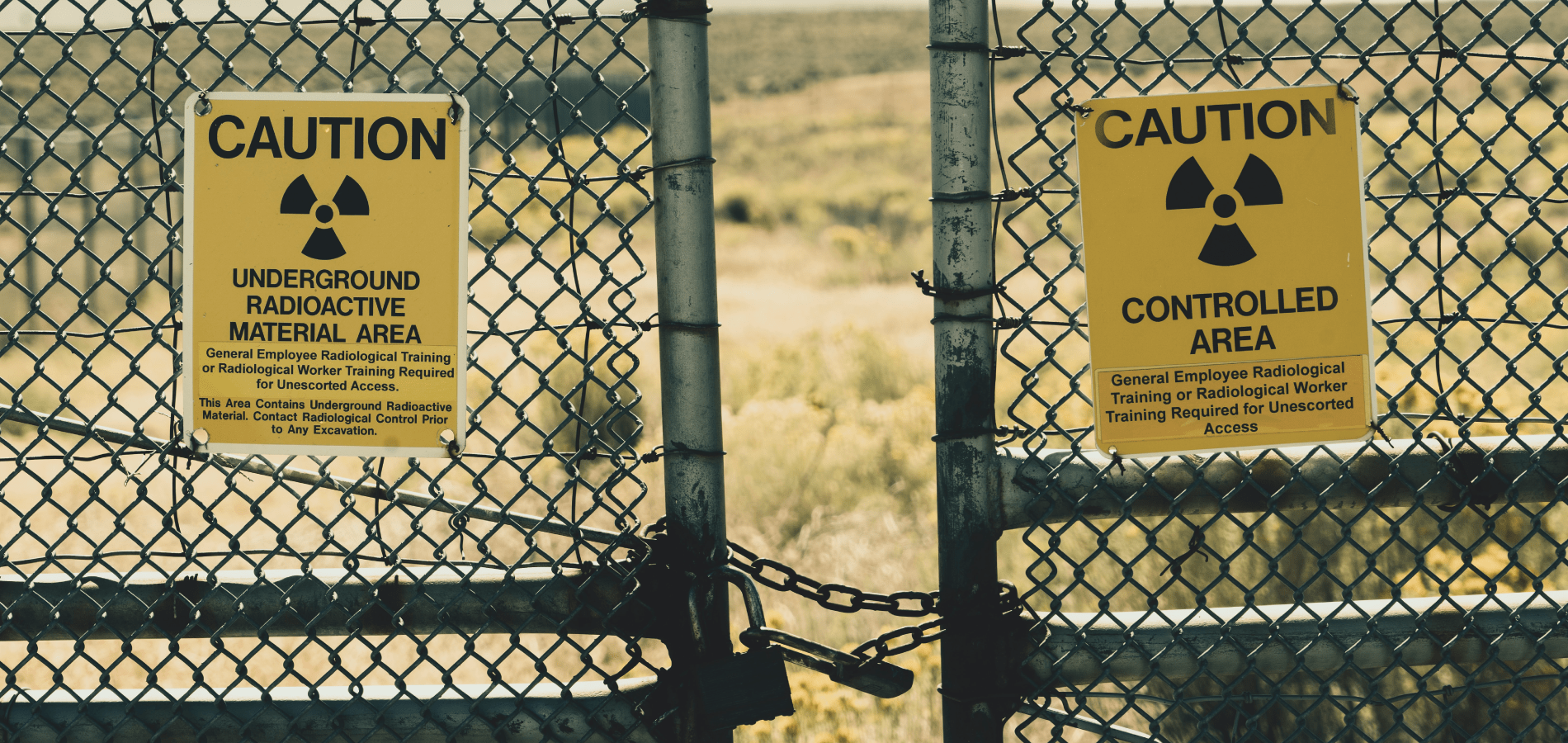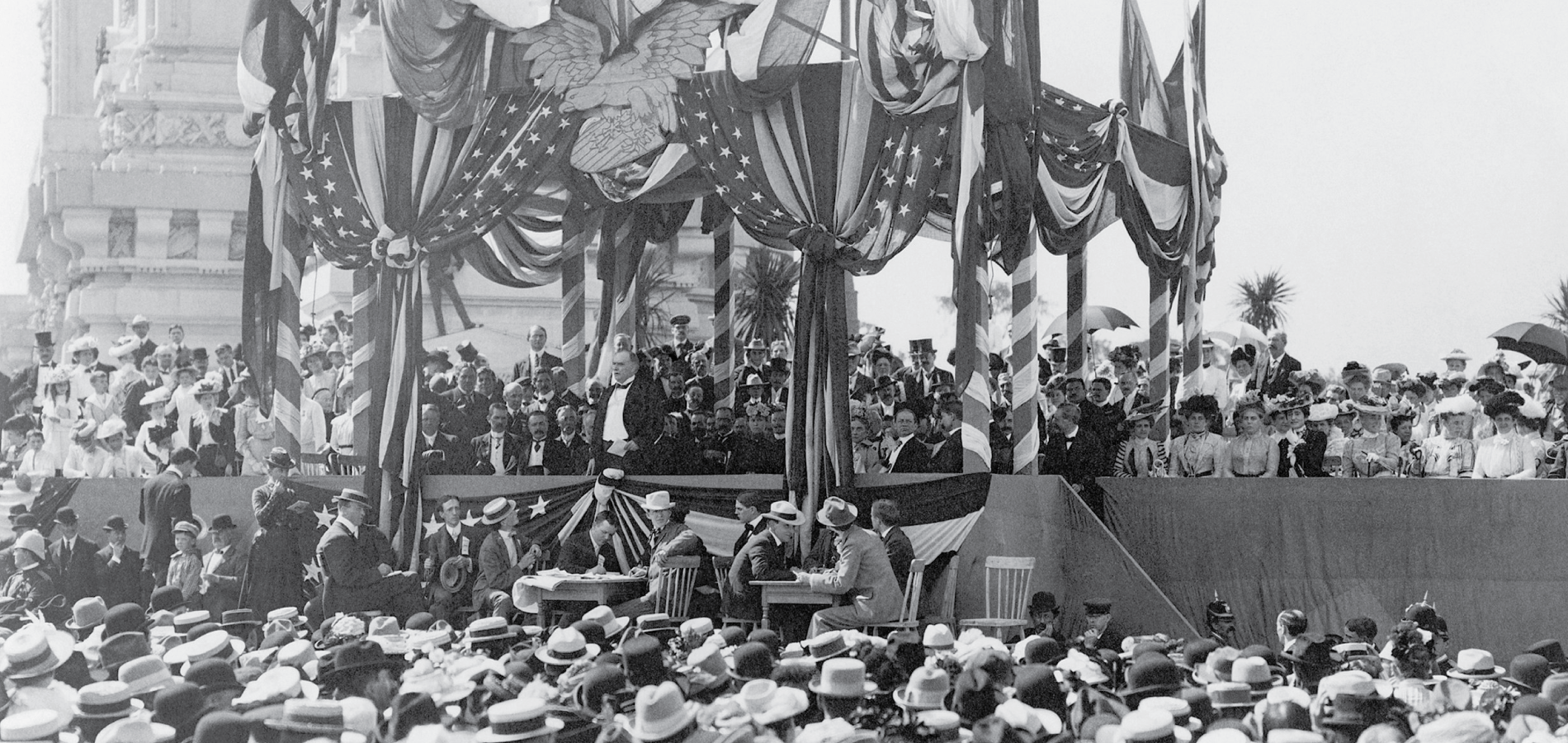Most of us have heard of the Red Scare—the period in the 1950s when, led by Senator Joseph McCarthy, the government sought to purge alleged communists from the federal government and from American society. Less discussed, however, is the Lavender Scare, which occurred around the same time and was a concerted effort to remove gay employees from the federal government. In honor of Pride Month, as well as the release of our new LGBTQ+ Rights database, this month’s Secrets of the Serial Set post will dive into this period of history which illuminates the progression of LGBTQ+ rights in America.
The Stigmatization of Gay Communities After WWII
After World War II, Americans found themselves moving out of the countryside and small towns toward cities, pursuing job opportunities and a more fast-paced lifestyle. In the cities, LGBTQ people were able to meet each other, and with the anonymity that cities offered, felt freer to form communities and express their authentic selves at a time when homosexuality was not accepted by the general public. However, this freedom did not last long. In 1947, a “sex perversion elimination program,”[1]622 (1950) Investigation of Crime and Law Enforcement in the District of Columbia, Hearings before a Special Subcommittee of the Committee on the District of Columbia, House of Representatives, 81st Congress, February 7, 9, 10, 13, 15, 17, 18, … Continue reading was established by the United States Park Police to target gay men[2]620 (1950) Investigation of Crime and Law Enforcement in the District of Columbia, Hearings before a Special Subcommittee of the Committee on the District of Columbia, House of Representatives, 81st Congress, February 7, 9, 10, 13, 15, 17, 18, … Continue reading—over 500 people were arrested under this act. A year later, Congress labeled homosexuality as a mental illness, creating an act “for the treatment of sexual psychopaths”[3]To provide for the treatment of sexual psychopaths in the District of Columbia, and for other purposes., Public Law 80-615 / Chapter 428, 80 Congress. 62 Stat. 346 (1949) (1948). This document can be found in HeinOnline’s U.S. Statutes at … Continue reading in Washington, D.C. Adding fuel to the fire, Joseph McCarthy insinuated that homosexuals were more likely to be communists—two of the 205 federal employees on his list of suspected communist federal employees[4]“State Department employee loyalty investigation. 2 pts.” U.S. Congressional Serial Set, , 1950, pp. I-34. HeinOnline, https://heinonline.org/HOL/P?h=hein.usccsset/usconset22638&i=8. This document can be found in … Continue reading were also homosexual. Americans began to relate homosexuality with communism, as both were seen as subversive, immoral ways of life that threatened traditional American values. Then, Deputy Undersecretary of State John Peurifoy attested that 91 homosexual employees had been dismissed from the State Department.[5]“State Department employee loyalty investigation. 2 pts.” U.S. Congressional Serial Set, , 1950, pp. I-34. HeinOnline, https://heinonline.org/HOL/P?h=hein.usccsset/usconset22638&i=346. This document can be found in … Continue reading Soon, all suspected LGBTQ individuals in government positions were targeted.

Investigations Begin
Republican Senator Kenneth Wherry and Democrat Senator J. Lister Hill began the first investigations[6]“Employment of homosexuals and other sex perverts in Government.” U.S. Congressional Serial Set, , 1950, pp. I-26. HeinOnline, https://heinonline.org/HOL/P?h=hein.usccsset/usconset22662&i=1624. This document can be … Continue reading of the two homosexual individuals on McCarthy’s list of alleged communists. They learned that 23 of the 91 homosexual employees fired from the State Department had been rehired in other government positions,[7]“Employment of homosexuals and other sex perverts in Government.” U.S. Congressional Serial Set, , 1950, pp. I-26. HeinOnline, https://heinonline.org/HOL/P?h=hein.usccsset/usconset22662&i=1634. This document can be … Continue reading leading Wherry to insist that employees needed to be thoroughly vetted for homosexuality. In addition, the Civil Service Commission began enforcing that reasoning be provided for all resignations and dismissals from government to prevent the rehiring of gay individuals. There are no records of the Wherry-Hill investigations beyond media coverage and two reports, one of which contained a statement from Lieutenant Roy Blick, head of the DC Metropolitan Police Department vice squad, who claimed—without any solid evidence—that there were 5,000 gay individuals in Washington, D.C. and that 3,700 of them worked for the federal government. Congress believed his testimony, so when Wherry suggested an extensive investigation within the government to weed out homosexual employees, the Senate agreed—on June 7, 1950, it agreed to launch an investigation of “the alleged employment by the departments and agencies of the Government of homosexuals and other moral perverts.”[8]“Investigation of employment of moral perverts by Government agencies.” U.S. Congressional Serial Set, , 1950, pp. 1-2. HeinOnline, https://heinonline.org/HOL/P?h=hein.usccsset/usconset22632&i=227. This document can be … Continue reading
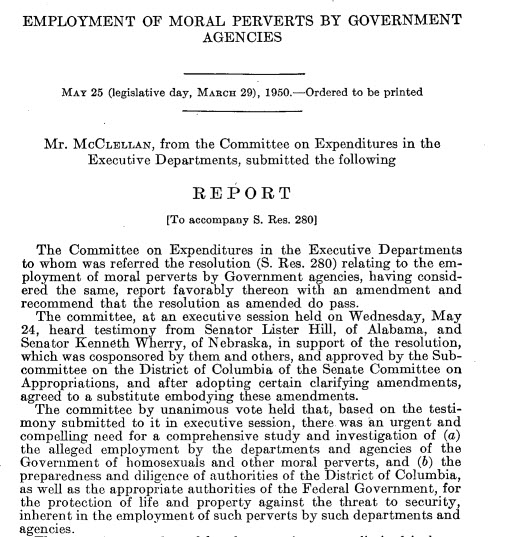
The Hoey Committee
A bipartisan committee led by chairman Senator Clyde Hoey[9]“Employment of homosexuals and other sex perverts in Government.” U.S. Congressional Serial Set, , 1950, pp. I-26. HeinOnline, https://heinonline.org/HOL/P?h=hein.usccsset/usconset22662&i=1621. This document can be … Continue reading was assigned to the investigation, which began with gathering information from federal agencies, law enforcement, courts, and the medical community. Those who testified varied in opinion as to the level of threat that gay individuals in government posed to national security. However, police across the country were instructed to reveal the federal employment status of all arrested individuals, and courts were required to enforce bail for any individuals facing a charge sexual in nature. As a result, any person caught in a homosexual act would face financial and employment repercussions, not to mention social stigma and disgrace. The gay community within Washington, D.C. was terrified—as Captain George Raines, a Georgetown University professor of psychiatry, put it, “I think you should know, those of us in town who have a large number of contacts are aware . . . that Government at this time has a rising wave of anxiety in it, a tremendous wave of anxiety. These people are frightened to death, and the agencies, some of them are frightened.” Suspected homosexual employees were investigated based on obscure evidence such as their marriage status, their style of dress, their voices, and other stereotypical characteristics of the gay community. Government employees were encouraged to turn in their coworkers.
The Formal Report
Following the investigation, the Hoey committee produced a report titled “Employment of Homosexuals and Other Sex Perverts in Government,”[10]“Employment of homosexuals and other sex perverts in Government.” U.S. Congressional Serial Set, , 1950, p. I-26. HeinOnline, https://heinonline.org/HOL/P?h=hein.usccsset/usconset22662&i=1620. This document can be … Continue reading which—largely based on opinion rather than fact—concluded that gay people posed a security risk in government positions because they were susceptible to blackmail, had a weak moral character, and drew other gay individuals to government positions. In fact, the report states that “One homosexual can pollute a Government office.”[11]“Employment of homosexuals and other sex perverts in Government.” U.S. Congressional Serial Set, , 1950, pp. I-26. HeinOnline, https://heinonline.org/HOL/P?h=hein.usccsset/usconset22662&i=1627. This document can be … Continue reading It also reported that nearly 5,000 gay individuals held government positions within the previous three years.
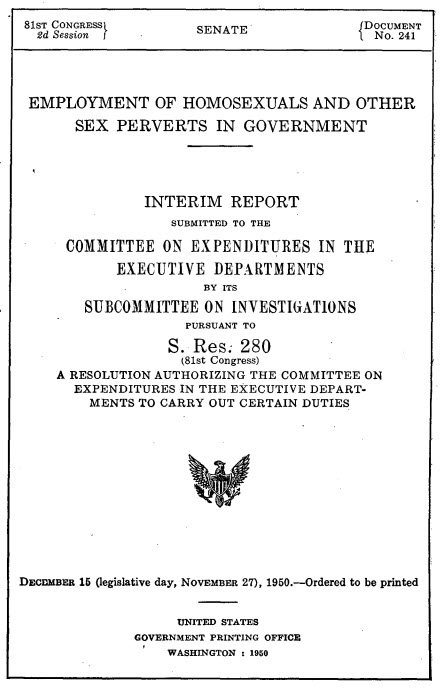
This report significantly affected how LGBTQ people were viewed not just in government, but in all aspects of American life. In addition, the report influenced President Eisenhower’s Executive Order #10450, “Security Requirements for Government Employment,”[12]SECURITY REQUIREMENTS FOR GOVERNMENT EMPLOYMENT, 3 CFR 72. This document can be found in HeinOnline’s Code of Federal Regulations database. issued in 1953 to establish sexuality as a qualification for federal employment—homosexual individuals were banned from the federal government and would remain banned until the 1970s. Thousands lost their jobs, were outed or were forced to hide their sexuality, and many died by suicide as a result.[13]Michele Goodwin & Erwin Chemerinsky, The Transgender Military Ban: Preservation of Discrimination through Transformation, 114 NW. U. L. REV. 751 (2019). This document can be found in HeinOnline’s Law … Continue reading
Fighting Back
Frank Kameny, a former civil servant who was fired for his sexuality in 1957, proceeded to petition the Supreme Court and picket the White House to protest sexual discrimination in the workplace. Gay rights organizations such as the Mattachine Society[14]“Amending District of Columbia charitable solicitation act. 2 pts.” U.S. Congressional Serial Set, , 1964, pp. 1-8. HeinOnline, https://heinonline.org/HOL/P?h=hein.usccsset/usconset22088&i=596. This document can be … Continue reading and the Daughters of Bilitis[15]Nan Alamilla Boyd, Shopping for Rights: Gays, Lesbians, and Visibility Politics, 75 DENV. U. L. REV. 1361 (1998). This document can be found in HeinOnline’s Law Journal Library. were formed during this period to protect members of the LGBTQ community. The Stonewall Riots of 1969 were also influenced by the Lavender Scare and helped to bring rights for LGBTQ people to the forefront of the nation’s conscience. However, Eisenhower’s executive order wasn’t effectively repealed until a 1995 executive order from President Bill Clinton[16]60 Fed. Reg. 40245 (1995), Monday, August 7, 1995, pages 40053 – 40258. This document can be found in HeinOnline’s Federal Register Library. stated that the government couldn’t discriminate based on sexual orientation, and an additional order 13087[17]63 Fed. Reg. 30097 (1998), Tuesday, June 2, 1998, pages 29933 – 30098. This document can be found in HeinOnline’s Federal Register Library. prevented employment discrimination based on sexual orientation. However, policies like Don’t Ask, Don’t Tell,[18]“Proceedings of 111th National Convention, Veterans of Foreign Wars of U.S.” U.S. Congressional Serial Set, , 2011, pp. i-289. HeinOnline, https://heinonline.org/HOL/P?h=hein.usccsset/usconset22808&i=645. This document … Continue reading which wasn’t repealed until 2010,[19]“Consideration of Senate amendment H.R. 2965.” U.S. Congressional Serial Set, , 2010, p. 1-4. HeinOnline, https://heinonline.org/HOL/P?h=hein.usccsset/usconset50697&i=378. This document can be found in … Continue reading ensured that true freedom for LGBTQ government employees would not fully be achieved until later. President Obama’s Executive Order 13764[20]Administration of Barack Obama, 2017 Executive Order 13764-Amending the Civil Service Rules, Executive Order 13488, and Executive Order 13467 To Modernize the Executive Branch-Wide Governance Structure and Processes for Security Clearances, … Continue reading amended civil service rules to officially repeal 10450 in 2017.
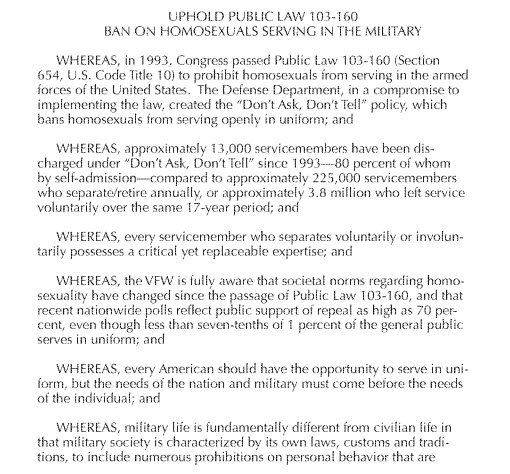
Help Us Complete the Project
Secrets of the Serial Set is an exciting and informative blog series from HeinOnline dedicated to unveiling the wealth of American history found in the United States Congressional Serial Set. Documents from additional HeinOnline databases have been incorporated to supplement research materials for non-U.S. related events discussed.
If your library holds all or part of the Serial Set, and you are willing to assist us, please contact Steve Roses at 716-882-2600 or sroses@wshein.com. HeinOnline would like to give special thanks to all of the libraries that have provided generous contributions which have resulted in the steady growth of HeinOnline’s U.S. Congressional Serial Set.
Continue Your Research with Our NEW LGBTQ+ Rights Database
Included in all HeinOnline Core subscriptions and free to any interested organization.
To continue honoring its core value of corporate citizenship, HeinOnline presents its newest addition to the Social Justice Suite, LGBTQ+ Rights. This collection charts the gay rights movement in America, showing the civil rights codified into law in the 20th and 21st centuries, as well as the inequalities that still exist today. All titles in this collection have been assigned one or more title-level subjects relating to their scope, and are further divided into six subcollections, whose areas of focus constitute Marriage and Family, Employment Discrimination, Military Service, AIDS and Health Care, Public Spaces and Accommodations, and Historical Attitudes and Analysis. The database includes an interactive timeline, as well as court cases, scholarly articles, books, pamphlets, reports, and more.
Continue your research on the Lavender Scare and the fight for LGBTQ+ rights by activating your free access. If you are a Core subscriber, then LGBTQ+ Rights has been automatically added to your HeinOnline subscription. Log in and check it out!
HeinOnline Sources[+]
| ↑1 | 622 (1950) Investigation of Crime and Law Enforcement in the District of Columbia, Hearings before a Special Subcommittee of the Committee on the District of Columbia, House of Representatives, 81st Congress, February 7, 9, 10, 13, 15, 17, 18, 20-21, 27-28, March 1-4, 1950. This document can be found in HeinOnline’s U.S. Congressional Documents database. |
|---|---|
| ↑2 | 620 (1950) Investigation of Crime and Law Enforcement in the District of Columbia, Hearings before a Special Subcommittee of the Committee on the District of Columbia, House of Representatives, 81st Congress, February 7, 9, 10, 13, 15, 17, 18, 20-21, 27-28, March 1-4, 1950. This document can be found in HeinOnline’s U.S. Congressional Documents database. |
| ↑3 | To provide for the treatment of sexual psychopaths in the District of Columbia, and for other purposes., Public Law 80-615 / Chapter 428, 80 Congress. 62 Stat. 346 (1949) (1948). This document can be found in HeinOnline’s U.S. Statutes at Large database. |
| ↑4 | “State Department employee loyalty investigation. 2 pts.” U.S. Congressional Serial Set, , 1950, pp. I-34. HeinOnline, https://heinonline.org/HOL/P?h=hein.usccsset/usconset22638&i=8. This document can be found in HeinOnline’s U.S. Congressional Serial Set. |
| ↑5 | “State Department employee loyalty investigation. 2 pts.” U.S. Congressional Serial Set, , 1950, pp. I-34. HeinOnline, https://heinonline.org/HOL/P?h=hein.usccsset/usconset22638&i=346. This document can be found in HeinOnline’s U.S. Congressional Serial Set. |
| ↑6 | “Employment of homosexuals and other sex perverts in Government.” U.S. Congressional Serial Set, , 1950, pp. I-26. HeinOnline, https://heinonline.org/HOL/P?h=hein.usccsset/usconset22662&i=1624. This document can be found in HeinOnline’s U.S. Congressional Serial Set. |
| ↑7 | “Employment of homosexuals and other sex perverts in Government.” U.S. Congressional Serial Set, , 1950, pp. I-26. HeinOnline, https://heinonline.org/HOL/P?h=hein.usccsset/usconset22662&i=1634. This document can be found in HeinOnline’s U.S. Congressional Serial Set. |
| ↑8 | “Investigation of employment of moral perverts by Government agencies.” U.S. Congressional Serial Set, , 1950, pp. 1-2. HeinOnline, https://heinonline.org/HOL/P?h=hein.usccsset/usconset22632&i=227. This document can be found in HeinOnline’s U.S. Congressional Serial Set. |
| ↑9 | “Employment of homosexuals and other sex perverts in Government.” U.S. Congressional Serial Set, , 1950, pp. I-26. HeinOnline, https://heinonline.org/HOL/P?h=hein.usccsset/usconset22662&i=1621. This document can be found in HeinOnline’s U.S. Congressional Serial Set. |
| ↑10 | “Employment of homosexuals and other sex perverts in Government.” U.S. Congressional Serial Set, , 1950, p. I-26. HeinOnline, https://heinonline.org/HOL/P?h=hein.usccsset/usconset22662&i=1620. This document can be found in HeinOnline’s U.S. Congressional Serial Set. |
| ↑11 | “Employment of homosexuals and other sex perverts in Government.” U.S. Congressional Serial Set, , 1950, pp. I-26. HeinOnline, https://heinonline.org/HOL/P?h=hein.usccsset/usconset22662&i=1627. This document can be found in HeinOnline’s U.S. Congressional Serial Set. |
| ↑12 | SECURITY REQUIREMENTS FOR GOVERNMENT EMPLOYMENT, 3 CFR 72. This document can be found in HeinOnline’s Code of Federal Regulations database. |
| ↑13 | Michele Goodwin & Erwin Chemerinsky, The Transgender Military Ban: Preservation of Discrimination through Transformation, 114 NW. U. L. REV. 751 (2019). This document can be found in HeinOnline’s Law Journal Library. |
| ↑14 | “Amending District of Columbia charitable solicitation act. 2 pts.” U.S. Congressional Serial Set, , 1964, pp. 1-8. HeinOnline, https://heinonline.org/HOL/P?h=hein.usccsset/usconset22088&i=596. This document can be found in HeinOnline’s U.S. Congressional Serial Set. |
| ↑15 | Nan Alamilla Boyd, Shopping for Rights: Gays, Lesbians, and Visibility Politics, 75 DENV. U. L. REV. 1361 (1998). This document can be found in HeinOnline’s Law Journal Library. |
| ↑16 | 60 Fed. Reg. 40245 (1995), Monday, August 7, 1995, pages 40053 – 40258. This document can be found in HeinOnline’s Federal Register Library. |
| ↑17 | 63 Fed. Reg. 30097 (1998), Tuesday, June 2, 1998, pages 29933 – 30098. This document can be found in HeinOnline’s Federal Register Library. |
| ↑18 | “Proceedings of 111th National Convention, Veterans of Foreign Wars of U.S.” U.S. Congressional Serial Set, , 2011, pp. i-289. HeinOnline, https://heinonline.org/HOL/P?h=hein.usccsset/usconset22808&i=645. This document can be found in HeinOnline’s U.S. Congressional Serial Set. |
| ↑19 | “Consideration of Senate amendment H.R. 2965.” U.S. Congressional Serial Set, , 2010, p. 1-4. HeinOnline, https://heinonline.org/HOL/P?h=hein.usccsset/usconset50697&i=378. This document can be found in HeinOnline’s U.S. Congressional Serial Set. |
| ↑20 | Administration of Barack Obama, 2017 Executive Order 13764-Amending the Civil Service Rules, Executive Order 13488, and Executive Order 13467 To Modernize the Executive Branch-Wide Governance Structure and Processes for Security Clearances, Suitability and Fitness for Employment, and Credentialing, and Related Matters , Daily Comp. Pres. Docs. 1 (2017). This document can be found in HeinOnline’s Federal Register Library. |

